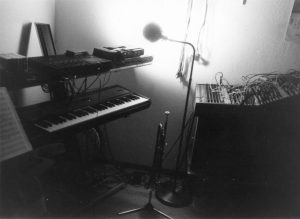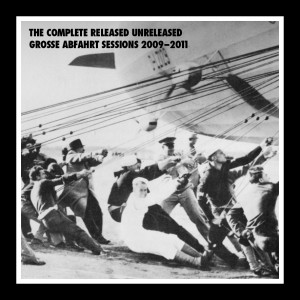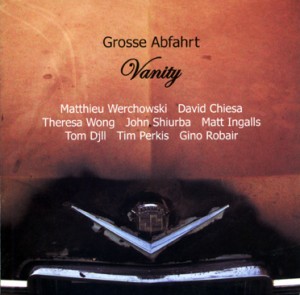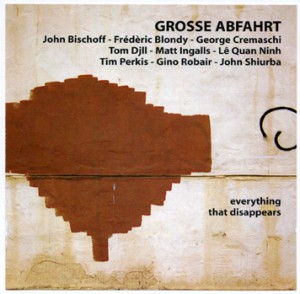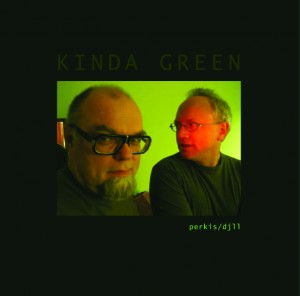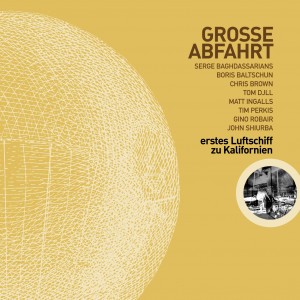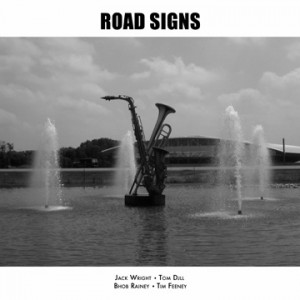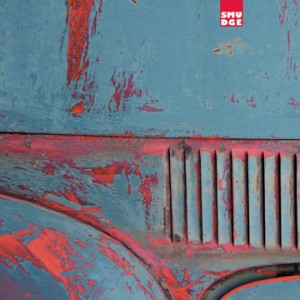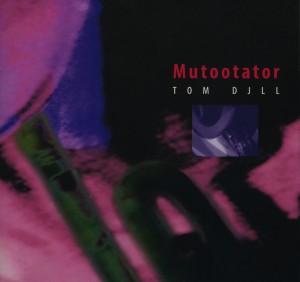25th Anniversary Re-release of MUTOOTATOR
Tom Djll duos with (in order of appearance):
William Winant
Myles Boisen
Tom Nunn
Jack Wright
Ron Anderson
Ed Herrmann
Doug Carroll
Hillary Double-D
Fred Lonberg-Holm
Thomas Scandura
1993 release on Soul on Rice Productions, Berkeley, California
MUTOOTATOR is now available on Bandcamp, including original CD issue!
When I came back from four months in Europe in 1987, I began working on solo music that more closely integrated my trumpet playing with the Serge Modular Music System. Much of that is documented in the Other Minds release Tom Djll: Serge Works.
Around 1990 I got my hands on a Digitech RDS 76, after lusting for the Lexicon PCM-42 for years and never having the cash to get one. Digital delays were large, rackmount affairs in the 80s and they cost a bundle, but the newly-released Digitech came relatively cheap. It took me a few months to realize that the voltage control inputs on the back of the unit — normally connected to foot pedals — would accept signals from my Serge. So all that delay-ing and looping (and echoing, chorusing, flanging, etc) could be made much more interesting. I was never too interested in the loop/layer usage of a delay to build up a thick texture or a canonic song, all stuff a zillion guitar players were already turning into clichés. But as soon as I ran the trumpet signal through the Digitech, and connected the Serge to the Digitech, I felt I had a brand-new, ripsnorting instrumental beast.
After another year or so, with Doug Carroll, Tom Nunn and Tom Scandura, I formed a band called STRITCH. Doug was using MIDI signals derived from his ‘cello playing to fire a sampler. Nunn created his own fantastically beautiful percussion instruments like THE BUG and THE CREATURE, and in those days was using effects pedals quite a lot. Tom was (still is!) the awesome punk-influenced drummer for The Molecules. Our sound was aggressive, alien, dense and multivalent. (TMK there is no sonic evidence online at this date to document STRITCH or its sound world.) We always recorded our rehearsals at Doug’s apartment above the TAP Plastics store in the Lower Mission in San Francisco (always free parking!). We gigged around the bay for maybe three years, playing at places like Hotel Utah, Radio Valencia, Olive Oyl’s, Beanbenders, the Chameleon, and the Heinz Club in Oakland. We also played a live, hour-long set on Ben Lindgren’s “Mob Ecstasy” show on KPFA radio. In the end, nothing got released from those sessions.
What came to be called “Improvcore” was blossoming in the early 90s. Bands like Rubber City, Pluto, The Molecules, OvaryAction, Idiot Flesh, Splatter Trio, Claeric Red F, Scattertactics, Mudwimmin, the Clubfoot Orchestra, Vacuumtreehead, and too many others I can’t remember, all bumped shoulders onstage during this time. We even formed an “Improvised Music Association,” arranged for publicity (see above), and put out our own zine, FREEWAY, and a cassette compilation. During the same period I played as a guest with The Molecules on a bunch of occasions and got to know guitarist/leader Ron Anderson. He had a hardscrabble studio in one of the grimmer East Oakland neighborhoods, and offered to record me in whatever configurations I chose. Wishing to foreground free improvisation, I decided on a series of duos.
Scandura, Nunn and Carroll were obvious choices. (seen above, L-R, and me in that idiotic fez) I was already deep into my playing partnership with Jack Wright. I had gotten to know Myles Boisen a little through odd gigs here and there, including an unforgettable “Improvisers Orchestra” thing put together by Steve Horowitz. (I contributed an avant-rocksteady/blues arrangement of an Erik Satie Gnossienne that Myles expressed enthusiasm for.) Another track from the Myles session ended up on his album “Guitarspeak.” Lonberg-Holm and Winant came from the Mills scene. Hillary Double-D was one of the many monikers for the woman in my life at that time. Sound engineer Ed Herrmann was a fellow Serge artist and had his own professional studio out in the Avenues in SF, which is where the sessions with him and Lonberg-Holm took place. Fred called his homemade electroacoustic stringed instrument the “travicello.”
Editing and sequencing was an agony of indecision and revisions. I eventually decided to interweave two longer takes featuring Wright and Anderson into a set of shorter alternating tracks (#s 5–9 on the disc). And, at the end of the whole process, I created a schematic “score” for the whole sequence, which I added to the booklet:
During one of Jack Wright’s visits in late 1992, a bunch of us like-minded improvisers took to Tom Nunn’s garage studio (“the Nunnery”) with video camera and recording equipment, and made a day of it. From that session came all the images for the jacket and tray card insert and booklet for the eventual CD. I hired a video artist recommended by Doug, named Sigi Torinus, to create stills of myself and other players from the footage that she altered. In addition to paying her full rate, I paid George Horn at Fantasy to master it, and a CD house to print 1,000 copies. I’m surprised, now, at how easily I spent all that money on something that, I knew even then, very few people wanted.
After two years the whole project was completed, and I threw a launch party/performance at the Berkeley Store Gallery. The date was October 27, 1993, just twenty-five years ago(!). I asked the irrepressible Daniel Plonsey to act as emcee and to do it “impersonating me.” He took the stage with no makeup or manners and announce, “I’m Tom Dill,” and succeeded beyond my wildest dreams in making much of the evening surrealistically awkward. The duos played that evening didn’t succeed as well, at least it seemed at the time. Somewhere I have a DAT of it.
Just a month before that concert, I had started the master’s course in the Center for Creative Music at Mills College…
R E V I E W S O F M U T O O T A T O R
Mutootator, a stunning set of duets with musicians including William Winant, Fred Lonberg-Holm, Tom Nunn and Myles Boisen… is well worth tracking down.”
I’ve made this stuff sound so damn serious! The disc is huge fun, as much Zappa as Stockhausen, the titles often as humorously evocative as the half-recognizable samples flitting in and out of focus. “Carnivore of Venice” finds Doug Carroll providing a basso continuo while Djll busts out misshapen loops that chase their own tails right out of the gate.
Veterans like Myles Boisen and William Winant appear and disappear along side folks with whom I’m entirely unfamiliar—who’s this Hillary Double-D, (Please don’t let my ignorance rob you of veteran status, Hillary!) and where can I hear more of her incisively random and socio-politically abstract poeticizing? Oh, I’ll just press play and enjoy it all again!
~ Marc Medwin, Bagatellen, 2006
Tom Djll presents himself here doing duos with a host of BayArea free musicians. The general sound is disjunct, constantly-changing and playful. If you always wished your old Morton Subotnick records got a little further out, or if you need a soundtrack for your own imaginary sci-fi film and feel disappointed that no extant sci-fi soundtracks can begin to be strange enough for your needs, “Mutootator” may well be your ticket. Several cuts remind me of insistent metallic insect hordes plowing migratory paths through dense, frenetic urban landscapes. So much music here comes from loosing the very rich wierdness sound potential inherent in electronics and synthesizers. Hence the Subotnick comparison (another Bay Area musician, by the way). Djll and his partners employ such rich textures that you feel your listening to small groups, not duos. Hymn of Lemuria is a high point here. Hillary Double-D’s vocals and Djll’s careful trumpet guidance make for a lilting, meditative piece of exceptional grace. Raster Bugs with Tom Nunn on amplified percussion boards is another standout. A laconic/nervous arc of night music that somehow calms you while indicating that there are unsettling things out in the pitch. Carnivore of Venice (with Doug Carroll’s amplified cello) is a witty little warped jaunt. Several frenetic jazz-oriented improvs fill out the album; they’re reminiscent of Company but with more humor. A varied, strong release.
~ Richard Grooms, The Improvisor, Vol. XI, 1996
Bay Area improv masters get together to play and rough up each other’s aesthetics with guitars, cellos, saxes, synths, and homemade percussion. Sometimes the improvised riffs get sampled and replayed, instantly adding another player or small ensemble to the group that’s already slashing away. The effect is jarring and intriguing, moving from airhorn-in-your-ear loudness to a kind of neurotic pianissimo, from sonorous marimba runs to the sckrechh! of something scraping the inside of your skull clean.
~ Richard Kadrey, Covert Culture Source Book 2.0, St. Martin’s Press (1994), p. 101, “New Music” section
I’m sitting here at the Mac struggling to find words to describe how overwhelmingly impressed I am with this work. The basic idea is this: take a modern jazz trumpet and feed it through a mind-boggling array of signal processing, sampling, back-looping and then more processing until you get a loping, drunken juggernaut-gargoyle unpredictably prancing like the proverbial china shop bull. Then, throw this insane mutant into an intensive, free-form improvisational environment with some of the most accomplished players available and what you end up with is so fresh, and yet so utterly sophisticated, as to almost defy description. Picture a three-way cutting contest between Beefheart, Varese and Yoko Ono; now picture it with the musicians licking venomous toads before playing; now picture it with you chewing jimson weed while you listen. Get the picture? Surreal, shimmering, trans-textural, amazing state of the art venusian swampstuff boogie. Get this NOW!!!
— Gajoob.com, 1994
++++++++++++++++++++++++++++++++++++++++++++++
The Complete Released Unreleased Grosse Abfahrt Sessions 2009 – 2011
Guest artists rumored to include (in alphabetical order (but they don’t play in alphabetical order)):
John Bischoff
Kyle Bruckmann
Tony Buck
John Butcher
Frank Gratkowski (here is an audio excerpt from this session)
Phillip Greenlief
Annette Krebs
Magda Mayas
Lisa Mezzacappa
MKM (Norbert Möslang, Jason Kahn, & Günter Müller)
Kjell Nordeson
Birgit Ulher
Plus the business+ class lighter-than-air crew of Shiurba, Robair, Perkis, Ingalls and Djll.
Format unconfirmed but said to be DVD audio, with special video enhancements. Limited hand-numbered edition of 500. Projected launch: summer 2012. More details to come. Watch the skies!!!
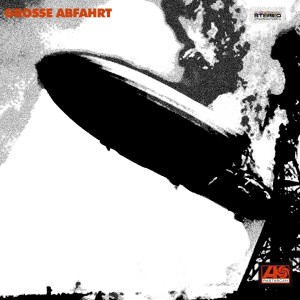 (Rare Grosse Abfahrt LP cover, ca. 1972)
(Rare Grosse Abfahrt LP cover, ca. 1972)
GROSSE ABFAHRT: Vanity
Emanem disc 5007, released 2009.
Available here.
Djll, Ingalls, Perkis, Robair and Shiurba reprise their roles, plus string section:
Theresa Wong, ‘cello
Matthieu Werchowski, viola & violin
David Chiesa, double bass
Recorded live to multitrack by Philip Perkins (See A Dog, Hear A Dog Studios)
Grosse Abfahrt is made up of a core group of five players which does not vary. These people are all very familiar with each other’s strengths, preferences, and foibles, yet they do not play as a quintet (well, on one occasion we did). To this core I add musicians who have not played with any of the core members. Often, these outsiders come from far away, and are playing as duos or trios already, so they arrive with some comfort and fluency in their own musical relationship. How these two dynamics come together to create music, with practically no introduction (much less, rehearsal), is our practice. This geo-socio-musical bridging encompasses some of the meanings of the name Grosse Abfahrt (‘great departure’).
For the present realisation, I added one more player (Theresa Wong) whose instrument was of the same family as the outsiders. Being a local, she was to perform as a kind of ‘bridge’ between the instrumental sounds of the Werchowski-Chiesa duo on the one hand, and the social identity of the core quintet. The Werchowski-Chiesa duo played a sensitive and soulful opening set, the second half of which is presented here as Hang Bat5 Over. With Theresa on cello, the three chamber strings formed a molten core to this Grosse Abfahrt. The music seemed to assemble itself into short pieces much of the time, although the evening featured a couple of longer discursions in the traditional Grosse Abfahrt style.
“The value of Djll’s reflections on group structure and interaction are apparent everywhere in the music. The special talents of Werchowski and Chiesa are apparent in an excerpt from an opening duo performance called Hang Bat5 Over, a performance of such resonant and meditative depth that it suggests some pieces by Arvo Pärt. Combining the strings with Wong and Shiurba gives a certain string dominance to the ensemble, and these sounds combine with the winds and electronics to emphasize sustained tones and rich, varied textures. Many of the full ensemble tracks are very brief. The opening Sportsman’s Paradise Music LA is less than a minute long and contrasts Webern-like evanescence with Chiesa’s contrarian pedal tone. Cthulu Kids First just a little longer and highly abrasive. As bracing as the miniatures are, though, it’s the more expansive improvisations that leave the strongest impression, like the sustained silence that develops between constant high and low pitches on Kablamo, a silence developed not by the absence of sound but by a missing frequency range, or the dialogue between string harmonics and electronics in CA Mirrors. Throughout this is improvised music of the very first order, and Djll’s visual artwork, colour photos of old cars and vanity plates, is as obliquely engaging as the music.” – Stuart Broomer, Point of Departure
“I’m sure that when trumpeter Tom Djll seized on the phrase Grosse Abfahrt for the name of this semi-regular group project, he was aware that English-speakers might regard the group name as an onomatopoeic representation of what your typical free-improv session sounds like, even if the phrase’s actual meaning – ‘great departure’ – is more representative of the highly disciplined way these players deal with the potentially chaotic prospect of large-ensemble improvisation. The central problematic (as they say in academe) in Grosse Abfahrt Mk III is the way the quintet’s highly abstracted and often electronic group sound enters into dialogue with the much more unified and familiar sound of a string trio. Though mostly this music’s about wavering, cumulative textures and near-miss drones, my favourite moments are often when these tensions really come to the fore in explicit juxtaposition, like the gorgeous bass pizz that kicks off Live Free or Die Delphi2 with a little finger-tapping ostinato while twinkling electronics slowly twist the universe into a knot, until, after the ensemble lurches into a momentary silence, the string trio flares up on its own. The enigmatic nature of the music is accentuated by the excluded-middle approach to duration: a bunch of really short tracks (usually about a minute and change), plus four long ones, which are considerably easier to get a hold on. One of the longer pieces (Hang Bat5 Over) is actually a Chiesa / Werchowski duet: at first dominated by the bassist’s incredibly elongated lyricism, the piece then undergoes an astonishing sea change as the violinist breaks in with enormous extended tremolos that create the illusion of an entire choir of voices – probably the most dramatic moment on the entire album.” — Nate Dorward, Paris Transatlantic
“Despite the contrasting instrumentations of the core and the outsiders, it never feels like there is competition – or combat – between the two. Rather, they complement and interact with each other. At times the electronics seem to emulate the sounds of the strings, fitting in with them but creating a distorting-mirror effect. The playing of both the core and the strings together frequently creates prolonged drone passages, which are overlaid with short passages of solo playing that bubble up to the surface, linger awhile and then merge back into the ensemble. Overall, there is quietude about the music; it evolves at a gentle, unforced pace that fits naturally with the sounds of the instruments. Somewhat atypical of the album as a whole is Hang Bat5 Over, just featuring the duo of Werchowski and Chiesa, without the core. The two engage in a prolonged – over ten minute – exchange of bowing that ebbs and flows between them with neither dominating. The bass and violin have sounds distinct enough to allow us to hear their individual lines, which weave in and around each other to good effect. It is one of those tracks that almost demands to be played again as soon as it is over, something that is equally true of the album as a whole. A good balance between fluency and comfort, with no hint of complacency.” — John Eyles, All About Jazz
GROSSE ABFAHRT: everything that disappears
Emanem Disc 4146 – Released 2008.
Available here.
The music was to strive toward long structures — my sole bit of direction to the ensemble. We formed this particular grouping just a few days after the death of Jean Baudrillard, whose book AMERICA served as the source for the album and track titles. I picked some pages from the book and read the first word from each line down to create the titles.
Djll, Robair, Shiurba, Perkis and Ingalls at their usual stations, plus:
Lê Quan Ninh, surrounded bass drum
Frédèric Blondy, piano
John Bischoff, electronics
George Cremaschi, double bass & electronics
Recorded by Michael Zelner, ZOKA Recordings
“What emerges is a series of highly tactile abstract sound paintings, each one flecked with vibrations from Djll’s frantically active and ambitious ensemble. A title like geometric undulating driveway symmetrical, all the road of masters could easily be associated with AMM, and in many ways — the ensemble’s almost Rowe-like use of electronics for example — Grosse Abfahrt could be viewed as a reflection of that great group, with guest musicians Blondy and Ninh (admittedly unintentionally) taking on the roles of John Tilbury and Eddie Prevost. That aside, this is a masterfully played and constructed example of big band improvisation with equally big ideas swarming through it.” —Edwin Pouncey, The Wire
“The group’s focus is on extended improvisation, long unwindings of sound in which instrumental identities submerge into collective mind. Even the track titles — vertical readings from Jean Baudrillard’s America — hint at new relationships in which sudden coherence may be as much the result of chance as intention and in which the fragmentary or discontinuous is equally valued. Thus, the longest track, geometric undulating driveway symmetrical, all the road of masters, is, at nearly 39 minutes, a world unto itself, populated with radio beeping, somber bowed bass and bass clarinet tones and a host of sounds that may defy ready identification. Everything appears hyper-resonant, from prepared trumpet to a sudden electric squiggle. While there’s an underlying continuum of sound for long stretches, and individual gestures might sound deliberated, this is by no means minimalist. Near the half-hour mark, there’s a sudden episode of skittering trumpet and bass that emphasizes the underlying unpredictability before the piece ends with a period of sustained high frequencies. Its ultimate shape, though, is always secondary to its immediate being, its sense of collective process…Throughout, though, this is valuable work, with its own distinctive concordances and frictions.” — Stuart Broomer, Point of Departure
KINDA GREEN • (CD-R – no catalog #) Release date: 2007.
Price: $8 – each one lovingly hand-made to order
Or download here.
It takes less than 48 minutes for these masters of noise-thumbing to murder this thing, and with it any semblance of critical standards in music-making. It’s not just a revolution in sound, it’s over 17,000 revolutions!
Here are just a few examples of what happens:
• Perkis “scratches” CDs of popular music using computer software while Djll scratches the plastic surface of a compact disc, using something sharp
• Djll blows through an obnoxious toy whizz-thingy while Perkis fucks with Hendrix
• Silence
• Perkis runs a pre-composed drone sample for 12 minutes while Djll goes to the bathroom (off-mic)
• Djll blows a drone-fart and Perkis hums along (for just a second or two)
• Perkis uses software he wrote to cut-up and replay samples of his own FM noise; Djll adds a second bell to his trumpet to create ear-tweaking stereophonic effects
• Both guys do the same weird shit they’ve been doing for 20 years
“I suppose, by sheer dint of its instrumentation, you’d have to file this under “EAI” – the album’s stately 22-minute closing track sagebrush drip kyrie certainly wouldn’t be at all out of place in the Erstwhile catalogue – but it’s a darn sight more sprightly and playful than most of the oh-so-dour stuff that excites the punters over at IHM. Then again, since when did EAI have to be all dreary drizzle?… Perkis’s laptop is as agile as eRikm’s kustomized Kaoss pads, whether squiggling and scribbling like your favourite DJ on “go”, or lobbing in sly snatches of Space Age Bachelor Pad pap (bottle glass window wing) and discreet field recordings – dig the crickets 15’ into the last track! Meanwhile Djll, in addition to being well-versed in the “extended techniques” that have now become de rigueur for any card-carrying improvising trumpeter – there are plenty of cold breathy blasts à la Dörner, Hautzingerian gurgles and pops, and a fondness for smearing his sound by jamming a sheet of metal [actually, a CD] across the bell that recalls Greg Kelley – reveals ample evidence of his ability to play real notes on the horn, and the right ones at that. And he’s not averse to blowing a huge raspberry here and there, lest you start taking it all too seriously. Excellent stuff.” — Dan Warburton, Paris Transatlantic
“The hoi polloi might not understand it but this is a great record, increasingly revealing its importance under amassed layers of unassumingly fascinating microcosms that probably not even their discoverers can give a name to.” — Massimo Ricci, Touching Extremes
erstes Luftschiffe zu Kalifornien
Creative Sources CS 065. Release date: 2007. Price: $15
On this release grosse abfahrt is all lowercase:
tom djll: composer, director, trumpet
serge baghdassarians: electronics
boris baltschun: electronics
chris brown: piano
matt ingalls: clarinet
tim perkis: electronics
gino robair: electronics
john shiurba: guitar
Recorded by john shiurba at ACME observatory, berkeley, oktober 10, 2004
Grosse Abfahrt is the name I gave the project on the occasion of its first recording, in 2004. In German, it means ‘great departure’. The project is to take a core group of Bay Area musicians and put them together with out of town visitors. In this way the ‘composition’ involves as much the clashes and synchronicities in social dynamics as much as sonic ecosystems.
… spare but remarkably tense collective improvisations… stays aloft beautifully…. a sense of restraint and purpose to these five pieces that’s rarely achieved in ensemble improv, either live or on disc. The only other medium-sized improv ensembles capable of such magic are the Boston-based BSC and the Berlin-based Phosphor collective, but even the latter’s eponymous debut album on Potlatch wasn’t as good as this. … one of the best discs you’re likely to hear all year. Überwältigend, as they say in Berkeley. – Dan Warburton (Paris Transatlantic)
… [It’s] quite engaging… by and large Grosse Abfahrt is successful in crafting a convincing, natural music, no mean feat for a mid-size ensemble. … fans of John Butcher’s interactions with various electronicists will certainly enjoy. In fact, to these ears, there’s not a weak cut among the five presented herein. – Brian Olewnick (Bagatellen)
…The dynamics brought in action by the players often inhabit the “ppp” neighbourhood, forcing our attention to appreciate the exquisite finesse that these strained synchronies involuntarily generate, the “lowercase factor” still in evidence during various segments of almost imperceptible “pneumo-electrology”. …A difficult, stimulating record that gradually uncovers fibres of grimy beauty. – Massimo Ricci (Touching Extremes)
Grosse Abfahrt (Creative Sources 065) is a fine summit meeting between European electronics whizzes (Serge Baghdassarians and Boris Baltschun) with six of the Bay Area’s finest: Chris Brown (piano and electronics), Tom Djll (trumpet), Matt Ingalls (clarinet), Tim Perkis (electronics), Gino Robair (analog synth), and John Shiurba (guitar). …covers your head with a thick electronic sheen. – Jason Bivins (Dusted)
…demands a big form of concentration, that is quite rewarding in the end. Parallels can be drawn to the music to that of MEV or AMM…It’s a marriage that works well, the meeting of electronic and acoustic sounds, and it makes this not really an easy CD, but certainly a most rewarding one. – Frans de Waard (Vital Weekly)
…This is one of the most un-played and self-disciplined works I’ve heard recently, the impression is that they develop a real interest in stirring just a few sounds in the performative place, that’s why even if I think the recording is good and the cd interesting it should have been a great session to be seen live… – Andrea Ferraris (Chain DLK)
…It’s impressive that one can gather together this number of musicians and engage in collective improvisation with no one stepping on another’s toes. The improvisations seem to grow organically and the music rarely falters. – Robert Iannapollo (Cadence)
Shades of Mimeo, the Creative Sources label presents an electroacoustic improv “supergroup” of sorts, assembled from around the world, centered in Berkeley…Grosse Abfahrt proceed to virtually tear apart pat analogs and instrument clarity in the service of yielding spectacularly unnerving (and previously unheard) results. …Overall, this is a protean work of electrical magic, outsourced from machines, bent into shape at the hands of their circuit manipulators, sounding like little else around. The octet’s name translates as “great departure” — can’t think of a better moniker with which to outfit any other explorers of sound this year. – Darren Bergstein (The Squid’s Ear)
ROAD SIGNS • SRPD 04 • Release date: 2006. Price: $8
The unofficial sequel to Jack Wright’s release “Signs of Life,” ROAD SIGNS re-partners Wright and Djll with saxist Bhob Rainey on two tracks and percussionist Tim Feeney on a third track. Recorded in Boston, Massachusetts and Rochester, New York in 2002 and 2005.
“The outright stunner here is the long track with Feeney, an endlessly dispersing/reforming sound-mobile which keeps turning up new aspects: pools of rust-coloured gloom, good-humoured babble, abrupt outbreaks of rasps and clatters, shivery high-pitched notes as sharp as a burin, streaks of metallic sound floating in the air virtually independently of any particular instrument. The longer of the two tracks with Rainey is nearly as good, and it’s a particularly clear example of how easily the trio can make enormous shifts of mood with the smallest of sonic adjustments – listen for instance to how the track’s abrasive opening moments morph before you know it into a softly murmuring chorale. This album may be starkly minimalist compared to most forms of music, but the emotional range and sound palette are astonishingly wide-ranging – and flavoured with a keen sense of humour, too. Essential listening for anyone following the micro-micro end of the current improv scene.” – Nate Dorward, Cadence
SMUDGE • SRPD 03 • Release date: 2006. Price: $8
Trumpet & sounds + digital processing. Incorporates 1988-1991 analog electronic works.
“Smudge presents both a recent and a more dated version of Tom Djll’s work with trumpet, analog synthesis (a Serge, for the record) and digital processing. It’s a delightful collection of mostly spacious ambiences whose adaptation to the context of your listening setting comes pretty easy, yet it’s absolutely far from minimal electronica, as the most static parts are interspersed with multiform emissions and variegated shapes, more evident in the pieces dating from 1988-91, where the synthetic guerillas of tracks like Exfoliate nod to the most complex ‘serious’ computer music a la James Dashow; but Djll’s compositions sound simply more beautiful.” – Massimo Ricci, Touching Extremes
http://touchingextremes.wordpress.com/archives-2001-2008-a-d/
bellerophone • SRPD 02 • Release date: 2006. Price: $8
Trumpet solos. Improvisations, compositions, two live tracks and one standard, “Brother, Can You Spare A Dime?” I sold two of these in Sacramento, so you know it’s the bomb.
“Tom Djll has been making thoughtful, elegant music for nearly 30 years and has taken the trumpet as far beyond its silver, snarling vernacular as it is possible to go, and as far from the extended technique proponents as Bill Dixon is from Roy Castle. By the time of the 2005 and 2006 recordings on Bellerophone, a belated solo release, almost all traces of trumpetness have been distilled away.” – Brian Morton, The Wire
MUTOOTATOR • SRPD 01 • Release date: 1993. Price: $8
Improvised duos with Myles Boisen, Jack Wright, William Winant, Tom Nunn, Fred Lonberg-Holm, Ron Anderson, Thomas Scandura, Ed Herrmann, Hillary D-D, Doug Carroll. The title refers to the hybrid analog-digital instrument Djll brought to bear in cutting up and processing his trumpet sounds.
“MUTOOTATOR, a stunning set of duets with musicians including William Winant, Fred Lonberg-Holm, Tom Nunn and Myles Boisen… is well worth tracking down.” — Dan Warburton, Paris Transatlantic, May 2006
http://www.paristransatlantic.com/magazine/monthly2006/05may_text.html#8 http://www.bagatellen.com/archives/row/001290.html (sadly, bagatellen is dead)


